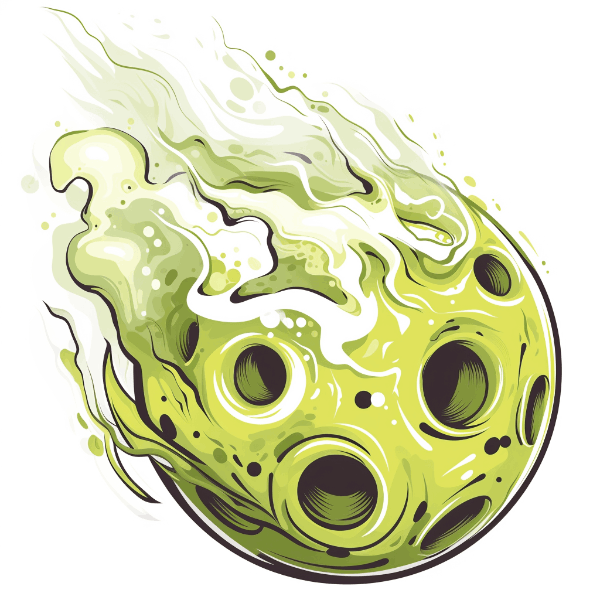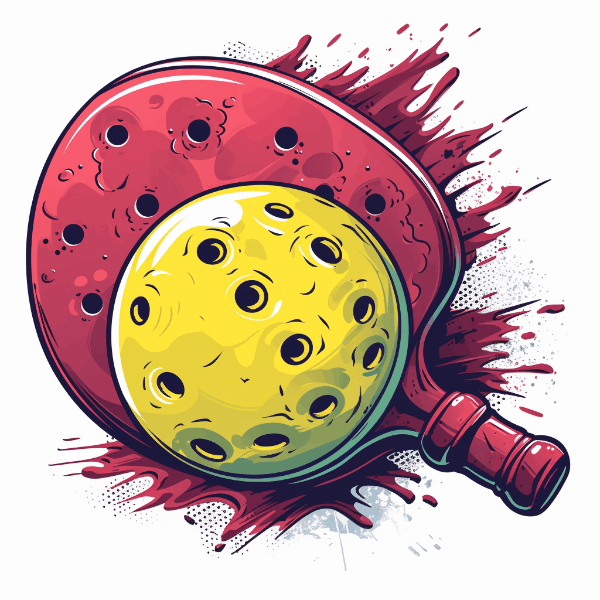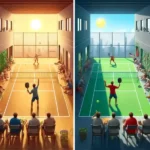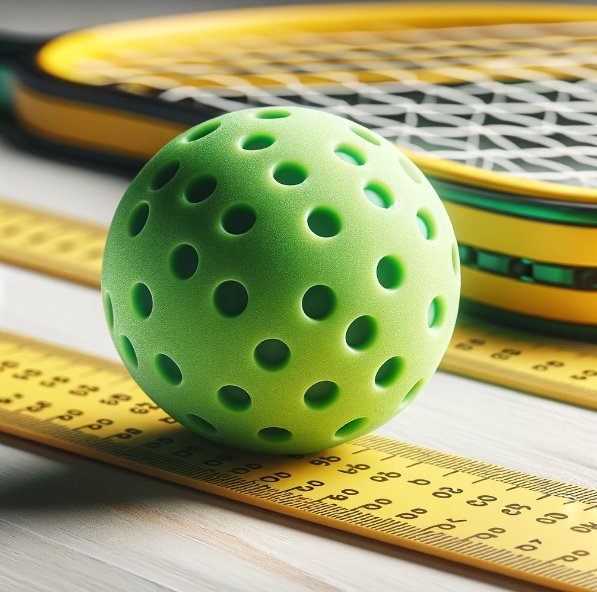If you’re passionate about the game, like many of us, you’ve probably wondered at some point, what is a pickleball made of? Knowing the construction and materials of a pickleball can help you choose the right ball for your game and improve your performance by about 5%. Therefore, let’s dive deep into the intricacies of what makes up this essential component of the game we all love.
Table of contents
- Materials Used in Pickleball Balls
- What’s the Difference Between a Pickleball Ball and a Wiffle Ball?
- Specifications of a Pickleball
- Indoor vs. Outdoor Pickleballs
- Why Do Pickleball Balls Have Holes?
- How Fast Do Pickleball Balls Travel?
- Longevity and Durability of Pickleballs
- How to Choose Pickleball Balls
- How Are Pickleballs Made?
- Conclusion
Materials Used in Pickleball Balls
Manufacturers use a durable plastic called polypropylene to make pickleball balls. This material offers excellent impact resistance and maintains its shape. Polypropylene, a thermoplastic polymer, is used in a wide variety of applications, from packaging and labeling to textiles and automotive components. Its properties make it ideal for the rigors of the game.
Key Properties of Polypropylene
| Property | Description |
|---|---|
| Durability | Withstands repeated impacts without cracking or deforming |
| Lightweight | Ensures the pickleball travels quickly through the air |
| Weather Resistance | Endures various weather conditions, suitable for both indoor and outdoor play |
Polypropylene is a versatile plastic that has become a staple in the production of pickleball balls due to its unique combination of strength, durability, and flexibility. This material can withstand the high-speed impacts common in pickleball games, making it ideal for both casual and competitive play. Additionally, polypropylene’s resistance to various weather conditions ensures that the balls perform consistently whether you’re playing indoors or outdoors.
What’s the Difference Between a Pickleball Ball and a Wiffle Ball?
While both have holes and are used in sports, they differ significantly in terms of materials and construction.
| Feature | Pickleball Ball | Wiffle Ball |
|---|---|---|
| Material | Polypropylene | Polyethylene |
| Construction | Rigid and durable | Softer and less durable |
| Purpose | Competitive and structured play | Casual backyard games |
The primary difference lies in the material and construction. Pickleball balls are made from polypropylene, which is more rigid and durable compared to the softer polyethylene used in Wiffle balls. This rigidity is crucial for maintaining a consistent bounce and flight path during play. Additionally, pickleball balls are designed for competitive and structured play, whereas Wiffle balls are more suited for casual backyard games.
Specifications of a Pickleball
To ensure fair and consistent play, pickleball balls must meet specific standards. According to the USA Pickleball Association (USAPA), a regulation pickleball must adhere to the following specifications:
| Specification | Measurement |
|---|---|
| Diameter | 2.87 to 2.97 inches |
| Weight | 0.78 to 0.935 ounces |
| Number of Holes | 26-40 evenly spaced holes |
These specifications ensure that pickleball balls are uniform in size, weight, and construction, providing a consistent playing experience for all players. The standard diameter and weight allow players to develop a feel for the ball, enhancing their control and accuracy during games.
How Many Holes Does a Pickleball Have?
The number of holes varies depending on its design for indoor or outdoor use. Indoor pickleballs typically have fewer, larger holes (around 26), while outdoor balls have more, smaller holes (up to 40). This difference helps each type of ball perform optimally in its intended environment.

Indoor vs. Outdoor Pickleballs
Manufacturers design indoor and outdoor pickleballs differently to accommodate various playing conditions.
What an Indoor Pickleball is Made Of
Indoor balls are lighter and have larger holes. This design reduces wind resistance, making the ball easier to control and providing a slower, more predictable bounce.
| Feature | Indoor Pickleball | Outdoor Pickleball |
|---|---|---|
| Weight | Lighter | Heavier |
| Hole Size | Larger | Smaller |
| Durability | Moderate (smooth surfaces) | High (handles rough surfaces and weather) |
Indoor pickleballs are specifically designed for play on smooth surfaces such as gym floors. The larger holes in indoor balls reduce wind resistance, allowing for greater control and precision. This design also provides a slower, more predictable bounce, which is ideal for indoor play where environmental factors like wind are not an issue.
What an Outdoor Pickleball is Made Of
Outdoor pickleballs are heavier and more durable, with smaller holes to handle wind and rough surfaces better. This construction ensures the ball withstands outdoor elements and maintains consistent performance.
Outdoor pickleballs, on the other hand, are built to withstand the elements. The heavier weight and smaller holes make them less susceptible to wind interference, allowing for more consistent play. Additionally, the durable construction of outdoor balls ensures they can handle rough surfaces such as concrete and asphalt without significant wear and tear.
Why Do Pickleball Balls Have Holes?
The holes in pickleball balls serve a critical purpose. They reduce wind resistance and control the ball’s flight path, ensuring a more predictable and enjoyable game. Additionally, the holes contribute to the unique sound pickleball is known for, which adds to the sport’s charm.
The number and size of the holes can significantly affect how the ball behaves during play. For instance, indoor balls, with their larger holes, are designed to move more slowly and predictably, which is ideal for indoor conditions. In contrast, outdoor balls have more, smaller holes to help them cut through the wind and maintain a consistent flight path even in less predictable outdoor environments.
How Fast Do Pickleball Balls Travel?
Pickleball balls can travel at speeds up to 40-50 mph during play. The speed depends on the force applied by the player and the conditions of the court. Consequently, outdoor balls tend to travel slightly slower due to wind resistance, while indoor balls can achieve higher speeds in controlled environments.
The speed of the ball can significantly influence the dynamics of the game. Faster balls require quicker reflexes and better anticipation from players, adding an exciting element of challenge to the game. Moreover, understanding the speed capabilities of different types of balls can help players adjust their strategies and improve their overall performance.
Longevity and Durability of Pickleballs
How long will a pickleball last? A pickleball generally lasts several games, but its longevity depends on the playing conditions and frequency of use.
| Condition | Longevity Estimate |
|---|---|
| Indoor Play | Longer due to smoother surfaces |
| Outdoor Play | Shorter due to rough surfaces and weather exposure |
Indoor balls tend to last longer because they are used on smooth surfaces that cause less wear and tear. In contrast, outdoor balls face rougher conditions, including abrasive surfaces and weather elements, which can shorten their lifespan. Regularly inspecting your pickleballs and replacing them when they show signs of wear can ensure you always play with a ball that performs optimally.
Do Pickleball Balls Wear Out?
Yes, pickleball balls wear out. Signs of wear include cracks, loss of roundness, and decreased bounce. Regularly inspect your pickleball balls and replace them when they show significant wear to maintain optimal play conditions.
The durability of a pickleball is crucial for maintaining the quality of play. Worn-out balls can lead to inconsistent bounces and affect the overall playing experience. Therefore, it’s essential to regularly check your balls for signs of wear and replace them as needed to ensure a fair and enjoyable game.
How to Choose Pickleball Balls
When selecting a ball, consider where you’ll be playing most often. If you play indoors, opt for balls with larger holes that are lighter and easier to control. For outdoor play, choose balls designed to withstand the elements, with more holes for better wind resistance.
Specifications to Look For
| Specification | Indoor Pickleball | Outdoor Pickleball |
|---|---|---|
| Material | High-quality polypropylene | High-quality polypropylene |
| Weight and Size | Standard regulation | Standard regulation |
| Holes | Larger and fewer | Smaller and more |
Choosing the right ball can significantly impact your game. Indoor balls with larger holes are easier to control and provide a slower, more predictable bounce, making them ideal for indoor play. Outdoor balls, with their smaller holes and heavier construction, are better suited for dealing with wind and rough surfaces.
How Are Pickleballs Made?
The manufacturing process of pickleballs involves several steps to ensure they meet regulatory standards and perform well during play. Here’s a simplified overview:
- Material Preparation: Manufacturers melt polypropylene pellets and mold them into a rough ball shape.
- Forming: They place the rough balls in a mold to form the final shape and punch holes through them.
- Cooling: The balls are cooled rapidly to maintain their shape.
- Quality Control: Inspectors check each ball for weight, size, and roundness to ensure it meets the required standards.
The manufacturing process begins with the melting of polypropylene pellets, which are then molded into a rough ball shape. These rough balls are placed in a mold to form the final shape, and holes are punched through them. After cooling rapidly to maintain their shape, each ball undergoes rigorous quality control checks to ensure it meets the required standards for weight, size, and roundness.
Conclusion
In summary, understanding what is a pickleball made of can significantly impact your game. Pickleballs are crafted from durable plastics like polypropylene, designed to withstand various playing conditions. Therefore, whether you play indoors or outdoors, choosing the right ball tailored to your needs can improve your performance and enjoyment of the game.



